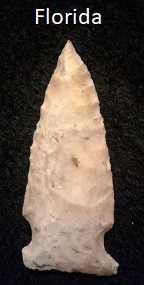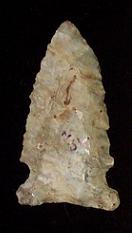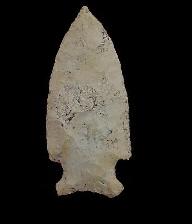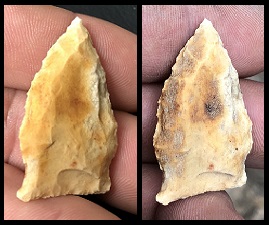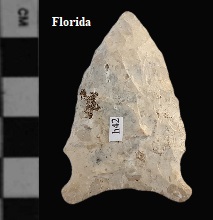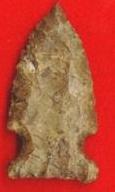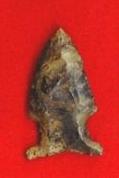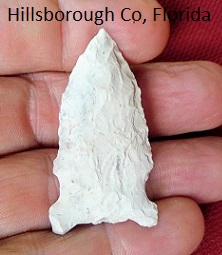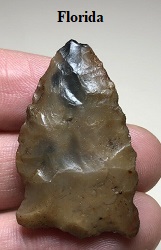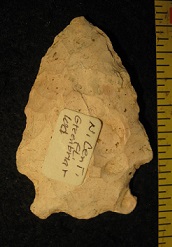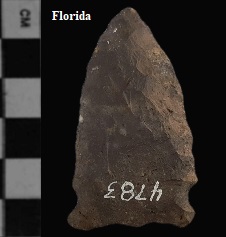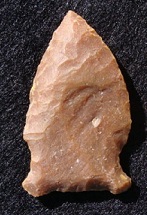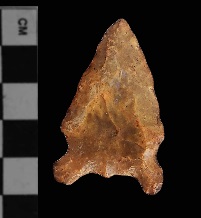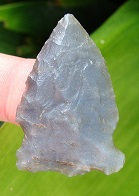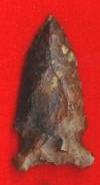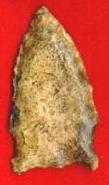Outline is Representative of Size and Shape:
 Double Notch Base
(Nipple Point)
Double Notch Base
(Nipple Point)
Subtype 2
 Concave Base
Concave Base
Subtype 1
 Double Notch Base
(Nipple Point)
Double Notch Base
(Nipple Point)Subtype 2
Subtype 1
Name Details:
Identified By: Ripley P. Bullen
Named For:
Date Identified: 1975
Type Site:
Identified By: Ripley P. Bullen
Named For:
Date Identified: 1975
Type Site:
Point Validity:
Valid type
Bullen was a distinguished anthropologist and Curator Emeritus of the Florida Museum of Natural History. He was dedicated to identifying and typing projectile points from Florida. This point was named in a professional publication and is professionally a widely recognized type. This is a valid type.
Bullen was a distinguished anthropologist and Curator Emeritus of the Florida Museum of Natural History. He was dedicated to identifying and typing projectile points from Florida. This point was named in a professional publication and is professionally a widely recognized type. This is a valid type.
Florida Greenbrier Notched
AKA: Osceola Greenbrier (Powell, 1990)Nipple Point (Snow, 1980)
Cluster: Large Side Notch Cluster
Description of Physical Characteristics and Flaking Pattern:
This is a medium to large triangular side notch point with a flattened to convex cross section. The blade is primarily excurvate. Fine serrations are commonly seen on the blade. The shoulders may vary from horizontal to having a upward slope. The stem is expanding. The base may range from concaved to having two shallow notches which forms a basal nipple. The hafting region has heavy grinding. This point has a random flaking pattern.
Size Measurements:
Total Length - 30 to 95 mm (average 45 to 55 mm), Stem Length - 10 to 15 mm, Width - 20 to 40 mm (average 28 to 34 mm), Neck Width - 15 to 25 mm, Thickness 5 to 9 mm
Total Length - 30 to 95 mm (average 45 to 55 mm), Stem Length - 10 to 15 mm, Width - 20 to 40 mm (average 28 to 34 mm), Neck Width - 15 to 25 mm, Thickness 5 to 9 mm
Commonly Utilized Material:
Additional Comments:
This point is commonly called the Osceola Greenbrier as described by John Powell in 1990. However this name is confusing because the name combines two unrelated types. This type represents a variant of the Greenbrier point which is consistent with the date and distribution of the Greenbrier point. This point should not be associated with the Osceola point which is not found within the same distribution. In addition, the Osceola point is a late Archaic to Early Woodland point while this is a Early Archaic point. Because of these inconsistencies, this point is listed here as the Florida Greenbrier which was the name first used by Ripley P. Bullen in his description of this point in 1975. Frankie Snow (1980) an avocational archaeologist refers to this point as the Nipple Point in literature.
Whatley (2002), included both of these types as Hardaway type points.
It is felt that the Union Side Notch was a precursor for this point, possibly the Nipple Variant of this point. The two share many of the same and overlapping characteristics.
The double notched base forms a nipple on the base. This nipple is similar to the striking platform used in the advanced fluting technique used by the Folsom and Cumberland point. No examples have been reported being fluted, but this may raise the question of this being an early variant of the Greenbrier point.
This point is commonly called the Osceola Greenbrier as described by John Powell in 1990. However this name is confusing because the name combines two unrelated types. This type represents a variant of the Greenbrier point which is consistent with the date and distribution of the Greenbrier point. This point should not be associated with the Osceola point which is not found within the same distribution. In addition, the Osceola point is a late Archaic to Early Woodland point while this is a Early Archaic point. Because of these inconsistencies, this point is listed here as the Florida Greenbrier which was the name first used by Ripley P. Bullen in his description of this point in 1975. Frankie Snow (1980) an avocational archaeologist refers to this point as the Nipple Point in literature.
Whatley (2002), included both of these types as Hardaway type points.
It is felt that the Union Side Notch was a precursor for this point, possibly the Nipple Variant of this point. The two share many of the same and overlapping characteristics.
The double notched base forms a nipple on the base. This nipple is similar to the striking platform used in the advanced fluting technique used by the Folsom and Cumberland point. No examples have been reported being fluted, but this may raise the question of this being an early variant of the Greenbrier point.
Distribution: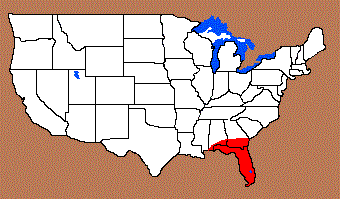
Distribution Comments:
This point is found in Florida and into southern Georgia and southern Alabama.
This point is found in Florida and into southern Georgia and southern Alabama.
Age / Periods:
Date: 9,000 - 7,000 B.P.
Cultural Period: Early Archaic
Glacial Period: Early to Middle Holocene
Culture:
Date: 9,000 - 7,000 B.P.
Cultural Period: Early Archaic
Glacial Period: Early to Middle Holocene
Culture:
Age Details:
Other points in this cluster / Related / Associated Points:
Big Sandy ,Cache River Godar, Graham Cave, Greenbrier, Hemphill, Howard County, Madison Side Notched, Osceola, Raddatz, Simonsen
Big Sandy ,Cache River Godar, Graham Cave, Greenbrier, Hemphill, Howard County, Madison Side Notched, Osceola, Raddatz, Simonsen


